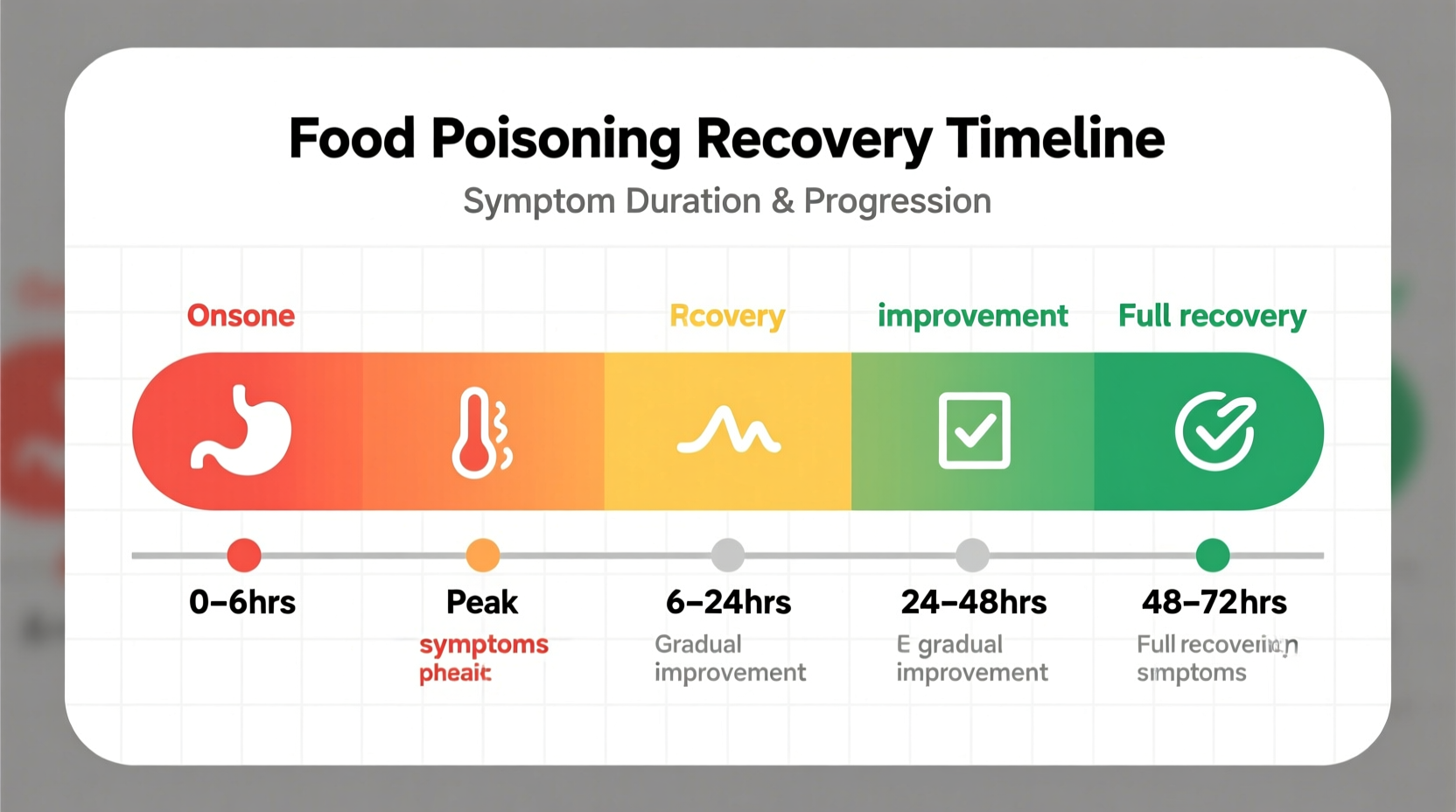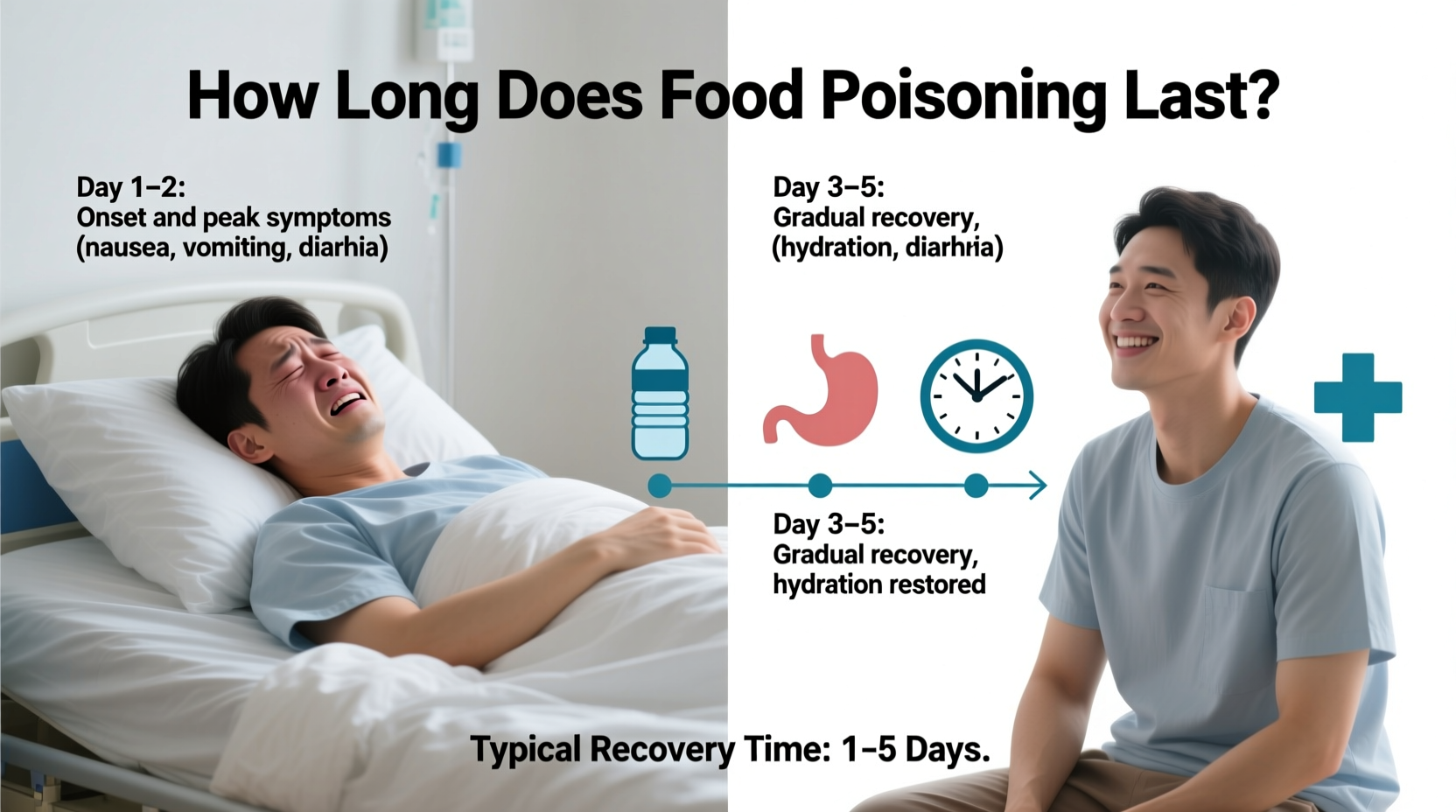When your stomach starts churning after a meal, your immediate question is likely: how long does food poisoning take to go away? Understanding the typical food poisoning recovery timeline helps you manage symptoms effectively and recognize when professional medical care becomes necessary. This guide delivers evidence-based information about food poisoning duration, recovery factors, and practical steps to support your body's healing process.
What Happens During Food Poisoning: The Biological Timeline
Food poisoning occurs when you consume contaminated food or beverages containing harmful bacteria, viruses, parasites, or toxins. Your body's reaction follows a predictable pattern:
- Incubation period (time from exposure to first symptoms): Ranges from 30 minutes to several weeks depending on the pathogen
- Acute phase: When vomiting, diarrhea, and cramps peak (typically 12-48 hours)
- Recovery phase: Symptoms gradually decrease as your body eliminates the pathogen
According to the Centers for Disease Control and Prevention (CDC), most healthy adults recover from common foodborne illnesses within 1-3 days through proper hydration and rest. Your immune system works to eliminate the pathogens while your digestive tract repairs itself.
Pathogen-Specific Recovery Timelines
Not all food poisoning is created equal. Different pathogens cause varying symptom durations. This comparison helps you understand what to expect based on the likely culprit:
| Pathogen | Typical Onset Time | Duration of Symptoms | Common Sources |
|---|---|---|---|
| Norovirus | 12-48 hours | 1-3 days | Raw shellfish, contaminated surfaces |
| Salmonella | 6-72 hours | 4-7 days | Raw eggs, poultry, unpasteurized milk |
| E. coli | 1-10 days | 5-10 days | Undercooked ground beef, leafy greens |
| Staphylococcus | 30 min-8 hours | 1-2 days | Foods handled by infected person |
| Listeria | 1-4 weeks | 1-3 weeks | Soft cheeses, deli meats, unpasteurized dairy |
Source: Centers for Disease Control and Prevention Foodborne Illness Symptoms
4 Key Factors That Influence Your Recovery Time
Several variables determine how quickly you bounce back from food poisoning:
1. Your Overall Health Status
People with compromised immune systems, chronic illnesses, or advanced age often experience longer recovery periods. The National Institutes of Health notes that older adults may take 50% longer to recover from foodborne illnesses compared to healthy younger adults due to decreased stomach acid production and slower immune response.
2. Pathogen Virulence and Quantity
The specific strain of bacteria and the amount you ingested significantly impact symptom severity and duration. For example, certain strains of E. coli produce shiga toxins that cause more severe and prolonged symptoms.
3. Hydration Management
Proper fluid replacement shortens recovery time by preventing complications from dehydration. The Mayo Clinic emphasizes that maintaining hydration reduces symptom duration by approximately 25% compared to those who don't adequately replace fluids.
4. Timing of Intervention
Starting appropriate treatment early—particularly oral rehydration—can shorten the acute phase. Research published in the Journal of Food Protection shows that beginning hydration therapy within the first 6 hours of symptoms reduces overall illness duration by 1-2 days.
When Food Poisoning Lasts Longer Than Expected: Red Flags
While most cases resolve within days, certain symptoms indicate you should seek medical attention immediately:
- Symptoms lasting longer than 3 days without improvement
- Signs of severe dehydration (dark urine, dizziness, rapid heartbeat)
- Blood in vomit or stool
- High fever (over 101.5°F or 38.6°C)
- Neurological symptoms like blurred vision or muscle weakness
The FDA Food Code specifically warns that prolonged symptoms could indicate serious complications like hemolytic uremic syndrome from E. coli or reactive arthritis from Salmonella. Don't hesitate to contact a healthcare provider if your symptoms persist beyond the typical food poisoning recovery timeline for your suspected pathogen.
Practical Recovery Strategies That Actually Work
While you can't magically speed up recovery, these evidence-based approaches help your body heal more efficiently:
Hydration Protocol
Replace fluids with oral rehydration solutions containing the right balance of electrolytes. The CDC recommends drinking 8-16 ounces of fluid after each episode of vomiting or diarrhea. Avoid sugary drinks and caffeine, which can worsen dehydration.
Nutrition Strategy
Follow the BRAT diet (bananas, rice, applesauce, toast) once you can keep liquids down. Recent research in Nutrients Journal shows reintroducing bland foods within 24 hours of symptom onset reduces overall recovery time compared to prolonged fasting.
Rest Optimization
Your body directs energy to fighting the infection. Prioritize sleep and avoid physical exertion until symptoms subside. Studies show adequate rest decreases symptom duration by approximately 30%.
When Medication Helps (and When It Doesn't)
Anti-diarrheal medications like loperamide can provide temporary relief but may prolong illness with certain pathogens like C. difficile. Consult a healthcare provider before taking any medication, especially if you have a fever or bloody stools.

Preventing Future Episodes: Practical Food Safety Measures
Understanding how long food poisoning takes to go away is important, but preventing it altogether is better. Implement these evidence-based food safety practices:
- Cook poultry to 165°F (74°C), ground meats to 160°F (71°C)
- Refrigerate leftovers within 2 hours (1 hour if temperature exceeds 90°F/32°C)
- Wash hands thoroughly before handling food and after using the bathroom
- Use separate cutting boards for raw meats and produce
- Check expiration dates and avoid bulging cans
The FDA Food Code establishes these standards to prevent foodborne illness. Following these guidelines reduces your risk of experiencing food poisoning and its uncomfortable recovery period.
Final Thoughts on Food Poisoning Recovery
Knowing how long food poisoning typically lasts helps set realistic expectations during an unpleasant experience. While most cases resolve within 1-3 days through proper hydration and rest, recognizing when symptoms indicate a more serious condition could prevent complications. By understanding the factors that influence recovery time and implementing practical strategies, you can navigate food poisoning with greater confidence and minimize disruption to your daily life.











 浙公网安备
33010002000092号
浙公网安备
33010002000092号 浙B2-20120091-4
浙B2-20120091-4